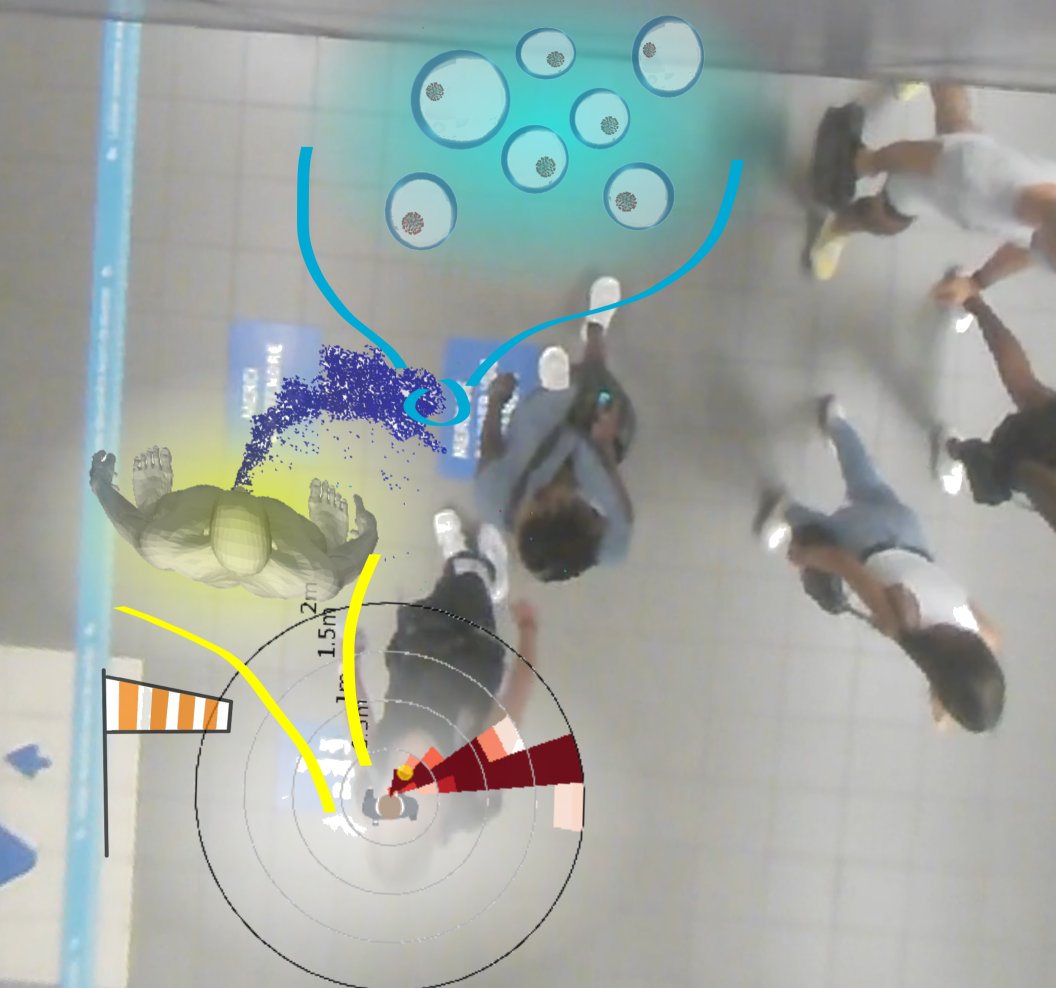
Transmission virale au sein de foules
Modelling viral spread in crowds
Willy GARCIA et Alexandre NICOLAS (équipe MMCI), en collaboration avec un collègue de Montpellier, ont publié un article intitulé "From microscopic droplets to macroscopic crowds: Crossing the scales in models of short-range respiratory disease transmission, with application to COVID-19" "dans la revue Advanced Science.
Willy GARCIA and Alexandre NICOLAS (MMCI team), together with a colleague from Montpellier, published an article entitled " From microscopic droplets to macroscopic crowds: Crossing the scales in models of short-range respiratory disease transmission, with application to COVID-19" in the journal Advanced Science.
Entre la taille des virus ou des micro-postillons qui les transportent et les dimensions caractérisant l’évolution d’une foule de personnes, il existe un gouffre de plus d’une demi-douzaine d’ordres de grandeur. Autant dire que faire la jonction entre ces deux bords pour évaluer les risques de transmission virale par exposition directe au sein d’une foule représente un défi théorique et numérique considérable ! Cette jonction est pourtant nécessaire, tant les détails fins de la propagation des micro-postillons comme le mouvement des personnes impliquées affectent, à leurs niveaux respectifs, la transmission aéroportée.
Une méthode efficace et frugale numériquement a été proposée pour enjamber ce gouffre ; elle repose sur la génération de cartes dynamique de concentration d’aérosols autour d’un émetteur potentiel. La méthode a été appliquée dans des cas concrets en milieux non confinés, sur la base de données de terrain sur les foules, pour aboutir à un classement des situations quotidiennes impliquant une foule. Cette étude fine a au passage établi à quel point la présence de vents ou courants d’air, même faibles, réduisaient les risques de transmission virale, contribuant à expliquer les risques plus faibles encourus à l’extérieur.
Une méthode efficace et frugale numériquement a été proposée pour enjamber ce gouffre ; elle repose sur la génération de cartes dynamique de concentration d’aérosols autour d’un émetteur potentiel. La méthode a été appliquée dans des cas concrets en milieux non confinés, sur la base de données de terrain sur les foules, pour aboutir à un classement des situations quotidiennes impliquant une foule. Cette étude fine a au passage établi à quel point la présence de vents ou courants d’air, même faibles, réduisaient les risques de transmission virale, contribuant à expliquer les risques plus faibles encourus à l’extérieur.
A chasm of several orders of magnitude in length scales separates viruses and the respiratory droplets carrying them from the typical distances over which a crowd evolves. Therefore, it does not come as a surprise that spanning this gap to get a robust assessment of the risks of short-range viral transmission in a crowd is a major theoretical and numerical challenge. That being said, such a junction is necessary, because both the details of the microscopic propagation of droplets and the motion of people in the crowd drastically affect the air-borne transmission of viral carriers.
A computationally efficient and versatile method was proposed to bridge this gap, via the generation of coarse-grained dynamic maps of aerosol concentrations around any potential emitter. This method was applied to (mostly outdoor) empirical situations with crowds, using field data, and enabled us to rank the situations by the risks of viral transmission that they raise. Aa a by-product of this detailed study, the dramatic effects of even light winds and air flows on transmission risks was quantitatively ascertained.
A computationally efficient and versatile method was proposed to bridge this gap, via the generation of coarse-grained dynamic maps of aerosol concentrations around any potential emitter. This method was applied to (mostly outdoor) empirical situations with crowds, using field data, and enabled us to rank the situations by the risks of viral transmission that they raise. Aa a by-product of this detailed study, the dramatic effects of even light winds and air flows on transmission risks was quantitatively ascertained.


















